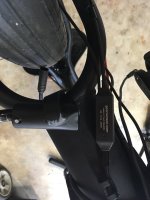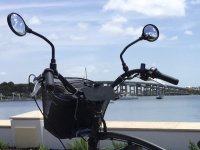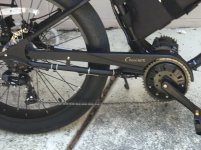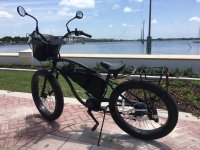This was the most challenging and rewarding part of my build. I had a huge triangle battery to mount to a frame that didn't have a triangle. I've read where other builders using this frame have just suspended the battery in the frame by the battery bag straps. This might be fine for experienced builders but it was too much of a stress factor for me. I had too many unknowns to deal with let alone a dangling battery (did I mention I'm in Florida LOL

. After scouring the Internet for ways to attach batteries to bikes I came across a builder who used pipe clamps to attach things to his bike. I made some measurements and off to Lowes I went.
Most of my DIY projects have been computer centric so Lowes, and home building supplies in general, is not a familiar place. Being as this was during the pandemic I wanted to be in and out as fast as possible and talk to as few people as possible. I had my measurements and a list of parts needed for my build such as heat shrink, electric tape, dielectric grease, hose clamps, spray paint, zip ties, scotch guard, and cable cutters etc. I managed to find most of what I had on my list without help. Now I needed to be inventive.
I had decided through measurements that I could make a shelf of sorts from the seat post tube to the headset tube that would emulate a regular bike's down tube to mount my battery to. The shelfs width was determined by the width of the two tubes that joined the headset of my bike which was 2 1/2" and the length needed to be long enough to fit the battery. I flipped the bike upside down and placed the battery against the top top and seatpost tube. I could then determine how far up the seat tube the shelf could be mounted. This let me determine the length at around 19". I needed something about 2 1/2" x 19" that I could attach to the pipe clamps and fasten to my bike.
I have all of the items on my list plus extras in case I had the wrong sizes and had to wander the store looking for that shelve thing. It occurred to me that there might be some sort of pre made shelf that would fit. I was looking for something strong, lightweight and waterproof and was the right size. I eventually stumbled on this bracket
CLOSETMAID 5660500 20" Shelf Bracket made as part of a set that looked like a suitable support. It was steel and u-shaped and the perfect length with a mounting that was at the perfect angle to reach the head tube. It was too skinny to support the whole battery but I figured I could attach something to the top. What that would be wasn't determined and nothing in the shelve section suited my needs. I thought something plastic might be good so I went searching for that when I discovered the glass and window section which has Lexan. Lexan is a clear polycarbonate that is strong, lightweight and waterproof. Perfect! Only problem is that they were out of stock due to the high demand as retail shields for the pandemic. I found nothing else suitable so I left with what I had.
While contemplating how I would attach my shelf to the bracket I considered various clamps and such but then I had the inspiration to use epoxy. This seemed more elegant as I didn't have to drill or cut into anything. I also felt that the epoxy along the whole length would make a stronger connection, it would reinforce the strength of the bracket and produce a cleaner look. With my new idea I headed to Home Depot where I found this sheet of lexan
24 in. x 18 in. x 0.093 in. Polycarbonate Sheet some Kwik Weld epoxy, a bag of 3/4" hose clamps and some flat black primer spray paint that matches my bike.
With all of my parts acquired I was ready to build this thing. My first step was to flatten the top of the bracket and open all of the hose clamps so I could paint the bracket and hose clamps. Next I needed to cut the lexan to a 2 1/2" x 19" strip. I searched youtube for videos of how to cut plastic and found this video
How To Cut Acrylic Sheet By Hand. I was going to attempt the scoring method outlined in the video when my brother-in-law offered a rotary tool he had for my use. I still thought the scoring method might produce a cleaner edge but I didn't have any suitable clamps so I went with the rotary tool.
The rotary tool was a godsend and made the whole project easier and more professional looking. The kit he loaned me had no cutting wheels so I ordered this set from Amazon
Cutting Wheel Set. I wasn't sure what wheel to use so I just grabbed one of the diamond wheels, I think. Cutting a straight line wasn't as hard as I thought. Unfortunately I cut it too short, oh well that was my practice cut. I turned the plastic sheet around so I would have at least one straight edge and cut another piece. This one came out the right length and the cut was a little bit straighter. I took both pieces and used my cement driveway as a large flat file and rubbed both pieces flat. I then smoothed both pieces with sandpaper and painted them.
I was originally going to glue everything together on my workbench but I found I could get a better placement if I mounted the bracket on the bike before gluing the shelf to the bracket. First I cut a piece at the base of the bracket to let the motor cable out. I had to order a longer cable to reach my handlebars since the bike is so long here's the cable I ordered from Amazon
1T4 Cable for Bafang I flipped the bike on the handlebars and strapped the battery to the top and seat tube to fit the placement of the battery one final time before mounting. I marked the position and I removed the battery.
I then used three painted hose clamps at the base of the bracket and on at the top. I placed pieces of rubber between the bracket and the frame to protect the frame and provide a better grip.
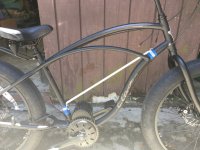 Bracket attached to frame
Bracket attached to frame
When I painted the bottom shelf I masked off a strip in the middle to epoxy the bracket on to.
 Strips painted
Strips painted
The strip on the right has tape down the middle
I placed the short one between the bag and the frame as a rainguard.
I mixed the epoxy and used the finger of a rubber glove to apply the epoxy to the lexan and a little on the bracket. I then placed my motor cable in the bracket. I clamped the shelf to the bracket with c-clamps and let it completely cure.
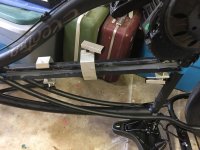 C-clamps
C-clamps
Once cured I sanded and painted the bottom of the shelf, careful to cover any areas for over spray.





